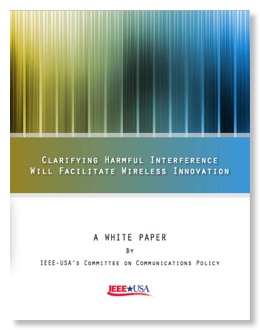IEEE-USA Harmful Interference White Paper
The document shown at right, a white paper entitled “Clarifying Harmful Interference Will Facilitate Wireless Innovation“, was released this week by IEEE-USA and was drafted by its Committee on Communications Policy. Here is the executive summary:
In recent years, many of the spectrum policy controversies in the United States have dealt with the basic issue of whether a proposed technology or service will cause “harmful interference” to existing spectrum users. Resolving these issues has typically taken several years in an era where technology is moving at “Internet speed.” As the Federal Communications Commission (FCC) discussed in its Wireless Innovation Inquiry, the delays and lack of transparency associated with making go/no go determinations on harmful interference may be discouraging private investment in the development of innovative wireless technology.
This White Paper reviews the background of what is harmful interference and suggests incremental ways in which the two spectrum management agencies in the United States, the FCC and the National Telecommunications and Information Administration (NTIA), could clarify the definition by giving guidance on the sub-problems associated with harmful interference determinations. Changing the definition is probably impractical, due to the long list of precedents over decades that have been built on the current definition, even though it is not established by statute.
The White Paper also suggests that establishing timeliness goals similar to those voluntarily created by the FCC for equally complex and voluminous merger and acquisition reviews could also address the disincentives for private capital formation in the wireless technology area. Such timeliness goals could create a more “level playing field,” with respect to other technical areas concerning private funding of technical development.




![Validate my RSS feed [Valid RSS]](valid-rss-rogers.png)

